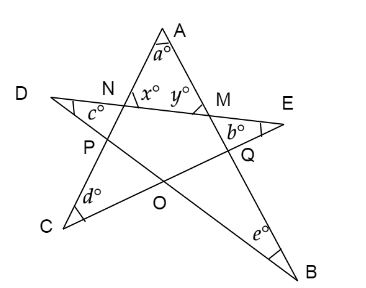
Look at the diagram of the irregular five pointed star.
(a) Explain why
(b) Explain why
(c) Show that the sum of the angles in the points of the star


Answer
393.6k+ views
Hint: In the above given question, we are given an irregular five pointed star which has different angles at each of the vertices. We have to prove the given objectives in the problem. In order to approach the solution, we have to recall two known properties in geometry. They are the angle sum property of a triangle and the exterior angle property of a triangle.
Complete step by step answer:
Given that, an irregular five pointed star AEBCD. We have to prove,
(a)
(b)
(c)
Now, from the figure, consider the line AMB. Since the angle of a straight line is
Also, in the triangle
From equation (1) and (2) we have
That gives us,
Hence, part (b) is proved.That is called the exterior angle property of a triangle.
Similarly, now consider the triangle
Also we have,
That gives us,
That is the part (a) proved here.
Now, since we have proved (a) and (b) , therefore we can write
That gives us,
Now by the angles sum property of a triangle
Hence, all the three objectives are proved.
Note: The angle sum property of a triangle states that the sum of all three angles of a triangle is equal to the straight angle i.e.
Complete step by step answer:
Given that, an irregular five pointed star AEBCD. We have to prove,
(a)
(b)
(c)
Now, from the figure, consider the line AMB. Since the angle of a straight line is
Also, in the triangle
From equation (1) and (2) we have
That gives us,
Hence, part (b) is proved.That is called the exterior angle property of a triangle.
Similarly, now consider the triangle
Also we have,
That gives us,
That is the part (a) proved here.
Now, since we have proved (a) and (b) , therefore we can write
That gives us,
Now by the angles sum property of a triangle
Hence, all the three objectives are proved.
Note: The angle sum property of a triangle states that the sum of all three angles of a triangle is equal to the straight angle i.e.
Recently Updated Pages
Master Class 11 Economics: Engaging Questions & Answers for Success

Master Class 11 Business Studies: Engaging Questions & Answers for Success

Master Class 11 Accountancy: Engaging Questions & Answers for Success

Questions & Answers - Ask your doubts

Master Class 11 Accountancy: Engaging Questions & Answers for Success

Master Class 11 Science: Engaging Questions & Answers for Success

Trending doubts
List some examples of Rabi and Kharif crops class 8 biology CBSE

What is the feminine gender of a stag class 8 english CBSE

Write five sentences about Earth class 8 biology CBSE

Summary of the poem Where the Mind is Without Fear class 8 english CBSE

How many ten lakhs are in one crore-class-8-maths-CBSE

Advantages and disadvantages of science




